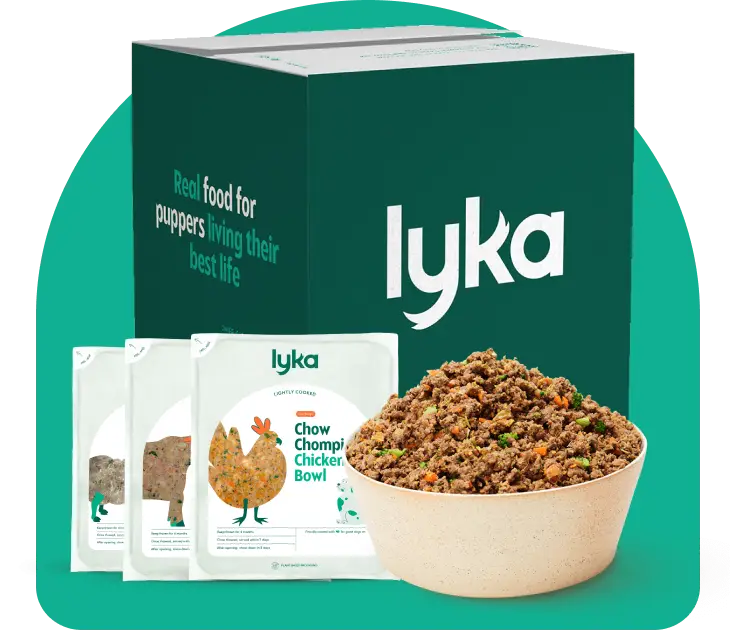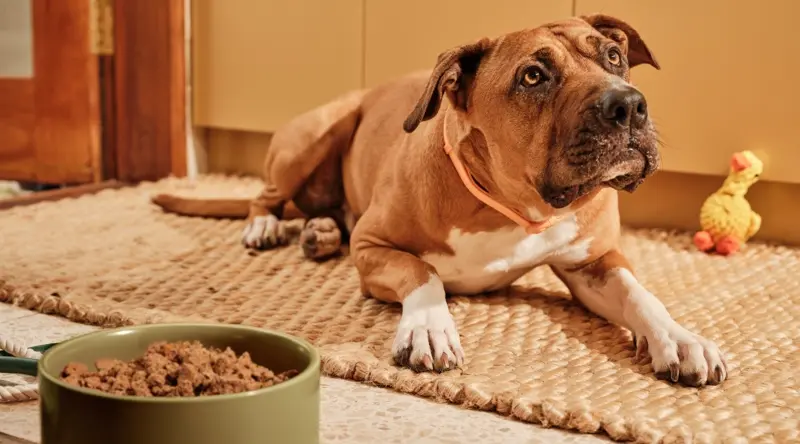A fussy pup can make mealtimes tough — worrying about whether they’re getting the right nutrients they need is stressful, especially when you’re doing all you can to keep them healthy and happy.
You’re not alone: fussiness is a common problem for pups, and anxiety can often be the underlying cause.
Anxiety and other mental health issues can affect how a dog engages with their environment, including their meals. Your pup’s appetite can also be impacted by other health conditions that make eating and digestion uncomfortable, triggering food-related anxiety.
Identifying the main cause and making key changes to your pup’s diet and feeding routine can encourage more successful mealtime experiences.
How does anxiety cause fussiness in dogs?
Anxiety in dogs (and humans) is a mental health condition and a broad term to describe feelings of stress, overwhelm, worry, or fear. Your dog might have an anxious temperament or there might be a specific trigger.
Let’s explore the link between these two issues and suggest some picky eater remedies for your dog.
)
Mental health
Anxiety and other mental health concerns can lead to fussy eating behaviours. Some dogs may have a fluctuating 'on and off' appetite, or suddenly go off their food when they feel triggered.
If your pup has separation anxiety your morning routine signals you’re about to leave for work. Some dogs may become preoccupied with this and less interested in their food.
Try this: mental health issues are complex to treat, but there are well-established links between nutrition and mental wellbeing. Removing the trigger or addressing the underlying cause can reduce your dog’s stress and support a good mood for food.
)
Changes to routine
Our pups are creatures of habit: it’s reassuring for them to know what to expect and when. If their day-to-day routine changes: you go on holiday, move house or even adjust the furniture, this can trigger feelings of anxiety.
Dogs are also sensitive to the addition (or loss) of another family member (pet or human) and can feel anxious or depressed as a result.
Try this: where possible, introduce changes gradually, so it’s less of a shock. Give your pup lots of love and hugs, if they enjoy the feeling of closeness.
Fear of missing out
Yes, dogs get FOMO too! Many pups love to be where the action is, so if mealtime coincides with family time or another distraction, they’ll be more inclined to value interacting than eating.
“Some people use food as a distraction for them to be able to go and do things — food going down on the floor becomes a precursor for us to be active and busy, so the pup may then avoid the food.” – Ian Shivers, Bondi Behaviourist Founder
Try this: create a mealtime routine and find a quieter spot for them to focus on their food.
The impact of trust
Dogs need to feel safe in their environment before they pop their head in their bowl. If they feel threatened or there’s competition for food, this can create stress and inappetence (loss of appetite).
Problems can arise if your pup has developed a habit of only eating from your hand. They learn to associate eating with the trust and comfort of having their pack leader close by and ignore what’s in their bowl.
Try this: establish a calm and private area that’s away from other pets so they can relax at mealtimes. Strengthen your bond of trust with more quality time together so your pup feels reassured by your connection and your clear and consistent commands, so you can gradually wean them off hand-feeding.
Transference anxiety
Dogs are very intuitive and can sense negative feelings and match our energy. Studies show that pups can read a human's facial expressions and even mirror their owner's stress — this is transference
Try this: remain neutral when you’re feeding your dog, so they don’t associate any negative emotions with mealtimes. If they don’t eat their food within the first 10-15 minutes, remove their bowl and try again later.
Sensory overload
If your dog has eaten the same, limited diet for a long time and they’ve recently changed to fresh food (like Lyka) they may need to get used to the new smells, tastes, and textures.
Try this: we always recommend a slow transition to Lyka to help your picky eater adjust to fresh, gently cooked food.
)
Other causes of fussiness and food anxiety in dogs
Inflammation
Low-grade inflammation, caused by leaky-gut syndrome (gut-hyperpermeability), can lead to fussiness.
Dogs with gut-hyperpermeability have a compromised gut lining barrier allowing particles and toxins to enter the bloodstream. This triggers an immune response leading to inflammation.
Gut-hyperpermeability often stems from imbalanced microbiome and food sensitivities and some dogs may refuse to eat food containing ingredients they react to.
“Fussiness can be a subtle sign of an increased gut permeability and a bacterial imbalance.” — Dr Matthew Muir, Lyka Co-founder and Integrative Veterinarian.
Try this: Lyka meals avoid pro-inflammatory starches, lectins, and common allergens like wheat, corn, or soy, often found in kibble. We also include anti-inflammatory, real food ingredients like ginger, turmeric, and omega-3 from fish and fish oil.
B12 deficiency
Vitamin B12 levels can influence your pup’s appetite, as it is crucial for healthy nervous and digestive systems. A deficiency may cause rapid weight loss and inappetence.
An imbalance in the microbiome (dysbiosis) can also impact your dog’s ability to absorb Vitamin B12. If they’re prone to a sensitive stomach or chronic enteropathy, a deficiency can be an issue.
Try this: fish, organ meat, red or white animal proteins, and eggs are a great natural source of B12. If you’re concerned about your dog's health, speak to your vet to ensure there are no other medical problems for their fussiness.
Food intolerances or allergies
Unknown food intolerances or allergies can lead to a negative association with certain foods. If your pup feels sick or itchy every time they eat a particular ingredient, they’re more likely to feel anxious at mealtimes and avoid their food.
Try this: if you’re not sure what to feed your fussy dog or you suspect a food intolerance or allergy, speak to your vet. They may suggest an elimination trial to identify the problem ingredient or food type, so you can exclude it from your pup’s diet.
Dog food ingredient labels can be confusing, which is why we believe in complete transparency. We share exactly what’s in each of our meals to make it easy for you to meet your dog’s dietary needs.
Cravings for sugar, salt, starch
Cravings for salt, sugar, and starch could be the cause of your pup’s pickiness. This is more common for dogs eating ultra-processed food like kibble that are full of sodium and high-glycaemic load carbohydrates (like wheat, corn, soy, and potatoes). Over time, pups can become reliant on these ingredients.
Try this: Lyka’s real food meals have a low-glycaemic load, and we use a controlled measurement of Celtic salt for its mineral value. We never include sugar — any natural sweetness comes from ingredients like fresh blueberries, raspberries, pumpkin, or sweet potato.
"Feeding a biologically appropriate, high-protein diet with plenty of healthy fats can help even the fussiest dogs enjoy their meals. Dogs often prefer to eat a diet high in protein and healthy fats rather than carbohydrates. If you have a fussy pup on a processed diet that’s high in carbohydrates, switching to a fresh diet can help." — Dr Darcy Marshall, Lyka Veterinarian
Not enough variety
While some dogs are perfectly happy to remain on the same food for life, others initially eat their food with gusto but can become bored of it.
Try this: Lyka meals are available in a range of 6 different proteins: beef, lamb, kangaroo, chicken, turkey, and fish. Variety can help pique their interest at mealtimes and keep them nourished with a complete and balanced diet.
Portion size
Feeding your dog once a day with a large portion might be too filling and calorific for them.
Try this: consider reducing their portions and feeding 2-3 times a day so they can enjoy and digest each meal, giving them a chance to feel hungry again.
Too many treats
If your pup isn’t hungry when it comes to mealtimes, they may be getting too many treats during the day.
Some dogs become picky over time — they learn if they wait long enough, they’ll get a higher value reward. It's common to feel frustrated with your pup’s pickiness, but if you reach for tasty treats, a juicy bone, or a portion of your own dinner instead, this could be creating a problem. Changing diets too regularly can also contribute to their disordered eating habits.
Try this: treats are a great reward for good behaviour and help to reinforce your bond, but overfeeding can affect appetite and lead to weight gain. A handy rule of thumb is to not exceed 10% of their daily caloric intake in treats.
Exercise and stimulation
If your pup isn’t getting enough exercise, they may not be expending enough calories to give their metabolism the kickstart it needs. Like us, a day of stimulation and exercise works up a healthy appetite.
Try this: a regular walk or playtime schedule can increase your dog’s appetite. It can also help deplete their stored energy so they’re less anxious.
)
Feeding Australia’s happiest dogs
More variety. More health benefits. More bowls licked clean. On Lyka, dogs don’t just eat well, they live well too.
Boost your pup’s digestion, improve B12 absorption, and support a balanced microbiome with real food meals packed with anti-inflammatory ingredients.
With 6 different proteins to choose from, each Lyka bowl is a nutritious delight. Even fussy eaters will lick the bowl clean!
Our Customer Care team are here to guide you every step of the way when it comes to feeding picky pups and our Lyka community have shared their tried and tested tips too.
)
)
)

)
)
)
)
